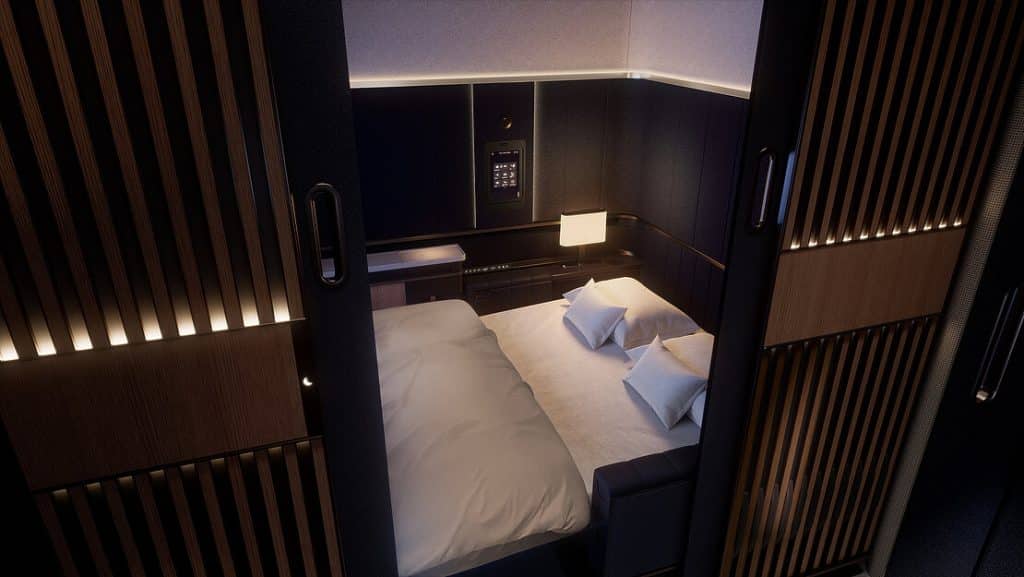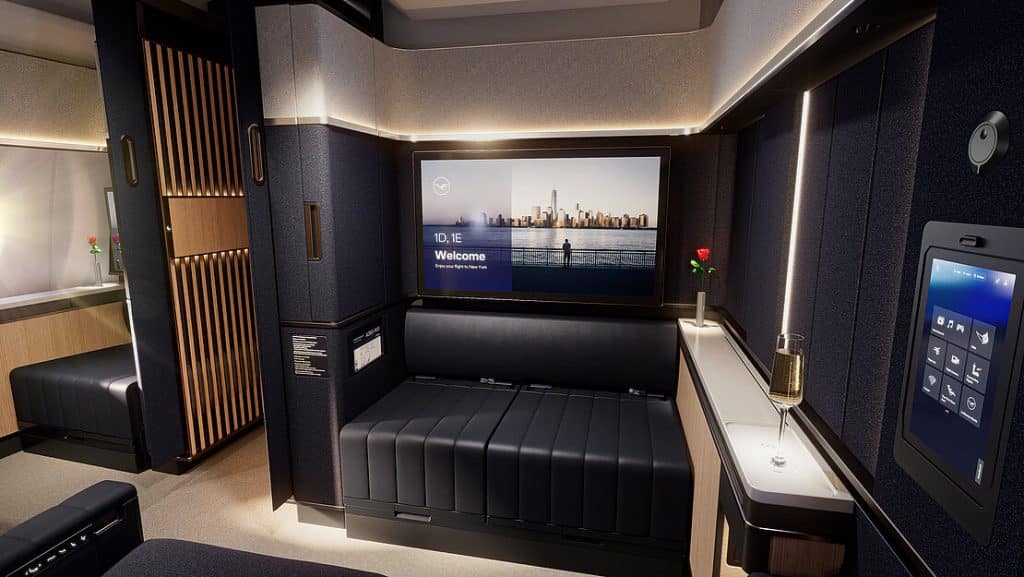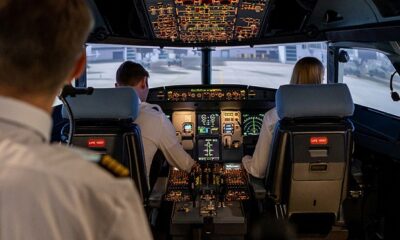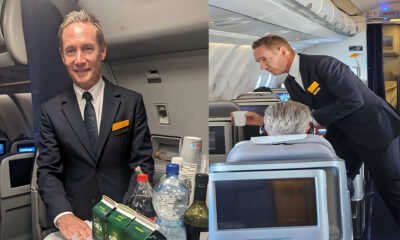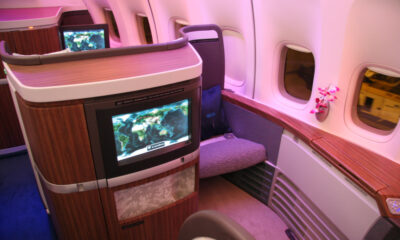Airlines
Lufthansa presents new “First Class Suite Plus” – private room above the clouds

Lufthansa is expanding its premium First Class offering with the “Suite Plus,” a separate double cabin with ceiling-high walls and an entirely closable door, a large table and two wide seats that can be combined into a comfortable double bed if required. With this flying private room, Lufthansa is setting a new standard in comfort and individuality within its most sophisticated travel class.
The First Class Suite’s features are unparalleled anywhere in the world: Guests can warm or cool their nearly one-meter-wide seats in the suite according to their personal needs and connect their own mobile device to the entertainment system. Ample storage space is provided by a suite wardrobe so that travelers can comfortably change and have all their personal belongings at hand.
Service at the highest level also awaits: The crew serves the gourmet menu at a time requested by the guests. The meal can be enjoyed in the private suites at the large First Class table, similar to a restaurant.
“Lufthansa Allegris”
The First Class will be introduced in 2024, on the newly delivered Airbus A350s as part of “Lufthansa Allegris,” the airline’s new long-haul product. In the process, the company is improving the overall travel experience for customers in all travel classes: Economy, Premium Economy, Business and First Class. “Allegris” is part of the largest product and service overhaul in the Lufthansa Group’s history, with a total investment of 2.5 billion euros by 2025.
Produktgeneration "Allegris": Lufthansa präsentiert neue Sitze und neues Reiseerlebnis in allen Klassen auf der Langstrecke, inklusive neuer „First Class Suite Plus“ – Privatzimmer über den Wolken für zwei – und Doppelsuite auch in der Business Class. ➡️ https://t.co/9EMd6DFpNa pic.twitter.com/BQ9UsE2zpX
— Lufthansa News (@lufthansaNews) February 28, 2023
Business Class: More flexible than ever
For the first time, guests in Lufthansa Business Class can also look forward to their own suite, which offers even more comfort and privacy due to chest-high walls and sliding doors. Here, travelers in the first rows can enjoy extended personal space, a monitor up to 27 inches in size and ample storage. Each suite also offers its own wardrobe and personal minibar. Inside, it is possible to connect the two suites so that business-class guests traveling together can enjoy a large degree of privacy.
With “Allegris,” the freedom of choice for Business Class guests has never been greater. Travelers can choose between six additional seat options, depending on whether they want an extra-long bed measuring 2.20 meters, extra space and work area, a seat with a baby bassinet, or simply an exclusive seat directly by the window. A double seat, in which the center console can be retracted to transform it into a reclining surface for two, is also available.
“Allegris” brings new aircraft to Lufthansa
With “Allegris”, more than 80 brand-new Lufthansa aircraft, such as Boeing 787-9s, Airbus A350s and Boeing 777-9s, will fly to destinations around the world. Aircraft already in service with Lufthansa, such as the Boeing 747-8, will also be retrofitted. The simultaneous improvement of the travel experience in all classes and the replacement of more than 27,000 seats are unique in Lufthansa’s history. In this way, the company is underscoring its clear premium and quality claim. By 2025, the Lufthansa Group will invest a total of 2.5 billion euros in product and service.

Airlines
A software error caused grounding the entire airline fleet

On Wednesday, the U.S. Federal Aviation Administration (FAA) issued a ground stop advisory for all Alaska Airlines and subcarrier flights due to a software issue, disrupting travel plans for passengers.
The FAA directive, which prohibited the departure of Alaska Airlines mainline and subcarrier flights, was implemented as a precautionary measure following the detection of the software problem. The ground stop was initiated after Alaska Airlines encountered difficulties during a system upgrade related to the calculation of weight and balance for their flights.
As a result, the airline opted for a temporary suspension of all its operations to address the issue and ensure passenger safety. Alaska Airlines promptly issued a statement acknowledging the incident and expressing their commitment to resolving the matter swiftly. “This morning we experienced an issue while performing an upgrade to the system that calculates our weight and balance.
Out of an abundance of caution, we requested a ground stop for all Alaska and Horizon flights, which was instituted at approximately 7:30 a.m. PT,” the statement read. Passengers affected by the disruption voiced their concerns on social media platforms, prompting Alaska Airlines to reassure them of their efforts to minimize the inconvenience and expedite the resumption of flights.
Following approximately an hour-long interruption, the FAA lifted the ground stop order, allowing Alaska Airlines and its subcarriers to resume normal operations. However, it was clarified that SkyWest, which provides regional service for Alaska Airlines and other carriers, was exempt from the ground stop and continued its flights unaffected.
Aerospace
Which is bigger 777x or 787 aircraft ?

The 777X is a new series of the Boeing 777 family and is designed to be larger and more efficient than its predecessor. It features two variants: the 777-8 and the 777-9, being the larger of the two.
The Boeing 777X emerges as the larger sibling within the Boeing family, representing a significant leap forward in both size and efficiency. Comprising two variants, the 777-8 and the 777-9, the latter takes the crown as the larger of the two. With its expansive fuselage and impressive wingspan, the 777X is tailored for long-range journeys and boasts a substantial passenger capacity.
On the other hand, the Boeing 787, affectionately known as the Dreamliner, occupies a niche in the market as a smaller yet formidable aircraft designed for medium to long-range flights. Its distinguishing feature lies in its composite fuselage, a technological marvel that renders it lighter and more fuel-efficient compared to conventional aluminum counterparts. The Boeing 777X is larger than the Boeing 787 aircraft.
When it comes to passenger capacity, the 777-9 reigns supreme, typically accommodating a sizeable contingent of 400-425 passengers in its standard configuration. In contrast, the 787, with its more modest dimensions, typically carries between 240-290 passengers, depending on the variant and layout.
One of the remarkable innovations introduced with the 777X is its folding wingtips, a feature designed to address the logistical challenges of accommodating such a large aircraft in conventional airport gates. These folding wingtips enable the 777X to retract its wings, allowing it to fit into gates designed for smaller aircraft while still reaping the benefits of an extended wingspan during flight, thereby enhancing fuel efficiency and operational flexibility
Airlines
Why Don’t Airplanes Fly Over the Pacific Ocean?

Flights do indeed fly over the Pacific Ocean, but the routes they take are often determined by factors such as airline policies, air traffic control decisions, and weather conditions. The Pacific Ocean is one of the largest bodies of water on Earth, and it’s regularly crossed by numerous flights traveling between North America, Asia, Australia, and other destinations.
However, some specific routes might avoid flying directly over certain parts of the Pacific Ocean for various reasons. For example:
- Safety and emergency considerations: While modern aircraft are equipped with advanced safety features, airlines, and pilots may prefer routes that keep them closer to potential diversion airports or within range of search and rescue facilities in case of emergencies.
- Air traffic control restrictions: Airspace management authorities may impose certain restrictions or preferred routes for managing air traffic efficiently. These restrictions could be based on factors such as military operations, airspace congestion, or diplomatic considerations.
- Weather conditions: Pilots and airlines consider weather patterns when planning routes. While the Pacific Ocean generally experiences fewer weather-related disruptions compared to other regions, factors like turbulence, thunderstorms, or tropical cyclones can influence route selection.
- Managing Cost Factors: In route planning, airlines have to take fuel prices, maintenance costs, crew charges, and other operating costs into account. Direct routes over the Pacific Ocean may be more cost-effective for shorter distances, but they may also necessitate extra safety precautions, including carrying more fuel for longer overwater operations.
- Remote Locations and Navigational Challenges: The Pacific Ocean’s vastness poses navigational issues, particularly for aircraft operating over isolated regions with few ground-based navigational aids. For precise positioning and route direction, pilots must mostly rely on satellite-based technology and onboard navigation systems, which may necessitate additional training and equipment purchases.
- Lack of Suitable Landing Options in the Pacific Ocean: Unlike regions with dense air traffic and numerous airports, the Pacific Ocean has vast stretches of open water with few suitable landing options in case of emergencies. While long-range aircraft are equipped with safety features like life rafts and emergency locator transmitters, the lack of nearby airports can increase the time it takes for rescue and recovery operations to reach distressed aircraft, posing additional risks to passengers and crew. Therefore, flight routes may be planned to ensure proximity to potential diversion airports or alternate landing sites in case of unforeseen circumstances.

